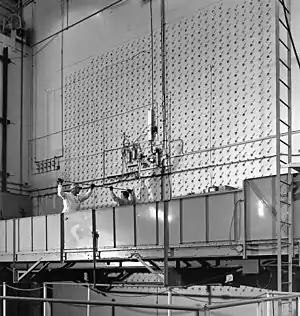Portal:Nuclear technology/Articles/28
The X-10 Graphite Reactor is a decommissioned nuclear reactor at Oak Ridge National Laboratory in Oak Ridge, Tennessee. Formerly known as the Clinton Pile and X-10 Pile, it was the world's second artificial nuclear reactor (after Enrico Fermi's Chicago Pile-1), and the first designed and built for continuous operation. It was built during World War II as part of the Manhattan Project.

While Chicago Pile-1 demonstrated the feasibility of nuclear reactors, the Manhattan Project's goal of producing enough plutonium for atomic bombs required reactors a thousand times as powerful, along with facilities to chemically separate the plutonium bred in the reactors from uranium and fission products. An intermediate step was considered prudent. The next step for the plutonium project, codenamed X-10, was the construction of a semiworks where techniques and procedures could be developed and training conducted. The centerpiece of this was the X-10 Graphite Reactor. It was air-cooled, used nuclear graphite as a neutron moderator, and pure natural uranium in metal form for fuel.
DuPont commenced construction of the plutonium semiworks at the Clinton Engineer Works in Oak Ridge on February 2, 1943. The reactor went critical on November 4, 1943, and produced its first plutonium in early 1944. It supplied the Los Alamos Laboratory with its first significant amounts of plutonium, and its first reactor-bred product. Studies of these samples heavily influenced bomb design. The reactor and chemical separation plant provided invaluable experience for engineers, technicians, reactor operators, and safety officials who then moved on to the Hanford site. X-10 operated as a plutonium production plant until January 1945, when it was turned over to research activities, and the production of radioactive isotopes for scientific, medical, industrial and agricultural uses. It was shut down in 1963 and was designated a National Historic Landmark in 1965. (Full article...)